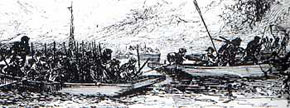Civil War Battles |
Colonial Wars |
American Wars |
Link To This Page — Contact Us —
The Battle of Brown's Ferry
October 27, 1863 in City/County, Georgia
Gen. Joseph Hooker
| Forces | Killed | Wounded | Captured |
| 1,365 | - | - | - |
Confederate Forces Commanded by:
?
| Forces | Killed | Wounded | Captured |
| - | - | - | - |
**Missing and Captured
Conclusion: Union Victory

BATTLE SUMMARY
The Battle of Brown's Ferry had a sole objective: Food. 40,000 Union soldiers were trapped in Chattanooga, a city of 2,000, after the disaster on the Union right at Chickamauga on September 20. Gen. William Rosecrans wired Lincoln, "We have no certainty of holding our position here..."
People in the north waited further word from Chattanooga, deep inside enemy territory. Gen. Braxton Bragg controlled the high points around the city to the east and south, and Lookout Valley to the west. Union forces were trapped. Only a treacherous supply route over Walden's Ridge kept Rosecrans' men alive. On the 22nd, Pres. Lincoln dispatched Gen. Joseph Hooker with 23,000 men from the Army of the Potomac to the city.
Union soldiers improvised a sawmill on the bank of the river, forming the pontoons and stringers necessary to build bridges. By early October, Hooker arrived at the railhead near Bridgeport, Alabama, preparing to open a supply line for the besieged Union Army. A master of inaction, Rosecrans delayed as his men starved. On October 16, Lincoln appointed Gen. Ulysses S. Grant head of the Departments of the Ohio, Tennessee and Cumberland. Grant immediately relieved Rosecrans of command.
Gen. George Thomas, the "Rock of Chickamauga," was appointed to fill Rosecrans' position. Grant ordered him to hold the city at all hazards.
On October 20, Thomas approved a bold plan to open a more direct supply line from Bridgeport put forward by Gen. William F. Smith, Chief Engineer of the Army of the Cumberland. Men would use the bridge pontoons to float past the Rebel guards on Lookout Mountain and along the banks of the Tennessee River, putting in at Brown's Ferry on the west side of the river. Additional men would cross the river after the landing as support.
Before the plan could be put into action, Grant arrived in Chattanooga. He approved "Baldy" Smith's plan on the 24th. The next day 2 Confederate regiments held as reserves were withdrawn from Lookout Valley. On the 26th, Gen. John M. Palmer left Chattanooga with a force of 4,000 men, marching west towards Brown's Ferry.
Thick fog rolled off the river early in the morning of the 27th. With the fog, Union troops under the command of William B. Hazen moved ashore. Earlier that night around 3:00 A.M., Hazen's men boarded 52 pontoons and rode the current of the Tennessee River around Moccasin Bend, past the Confederate pickets both on Lookout Mountain and along the riverside. Upon landing, the soldiers drove back the Confederate forces in the vicinity of the ferry.
As Hazen's men landed and fighting erupted, Palmer's men crossed the river towards the sounds of battle. The men from the pontoons advanced, trying to take the high ground near the river, while Palmer's men formed a 2nd line near the beachhead. A weak Confederate counter-attack drove Hazen's men back, almost to the beachhead, but the Confederates retreated in the face of a mounting Union presence.
Hazen's men catiously advanced. Unaware of the whereabouts or strength of their opponents they entrenched as soon as they reach high ground. After constructing abatis for protection, they build signal fires so that reinforcements crossing the river could find their position. By noon "Baldy" Smith's engineers completed the bridge across the Tennessee River.
From Bridgeport, Hooker advanced towards Chattanooga and the rapidly expanding Union beachhead at Brown's Ferry. Taking mountain passes leading to Lookout Valley and establishing a line of communication, he met Hazen's men at 4:00 P.M. on October 28. The famous "Cracker Line" was open.
Word of the success of Baldy Smith's operation brought rejoicing in the streets of Chattanooga, although it would be a week before enough food arrived to adequately feed the men of the Army of the Cumberland. Over the next month, the pontoon bridge built by Smith's engineers would see a nearly continuous line of men, munitions, food and supplies.
But the Confederates had a surprise of their own. Building heavy rafts on Chickamauga Creek near its confluence with the Tennessee River, the Confederates took advantage of heavy rains and launched the rafts on November 22, 1864. High water and the Confederate attack caused the bridge at Brown's Ferry to collapse as troops prepared for the Battle of Lookout Mountain.
